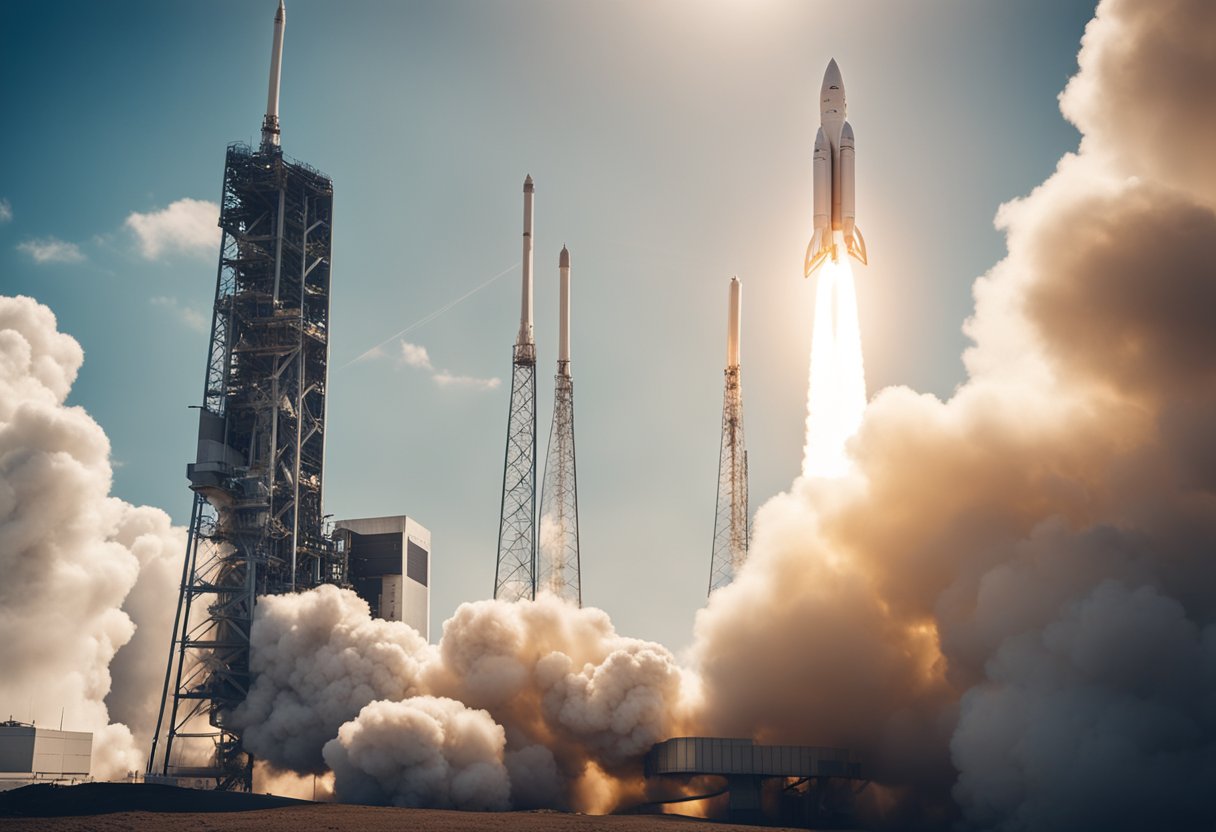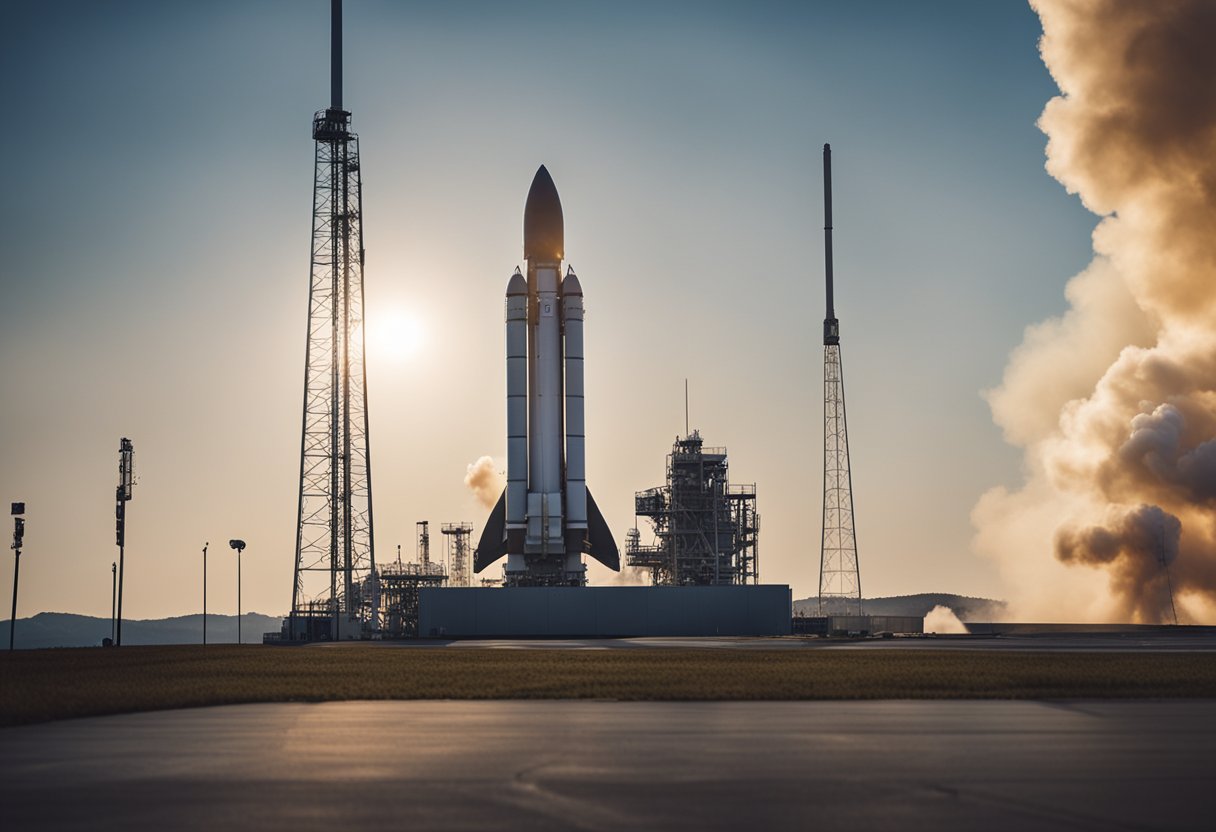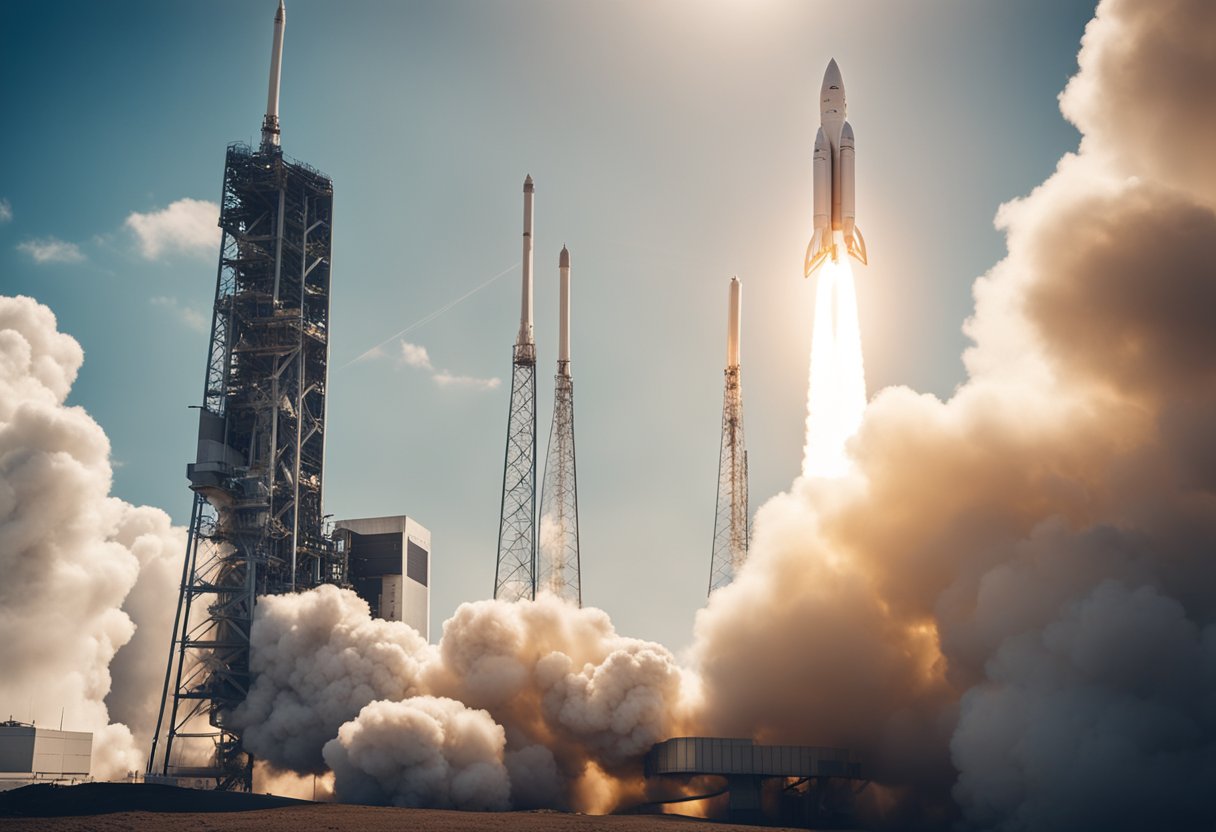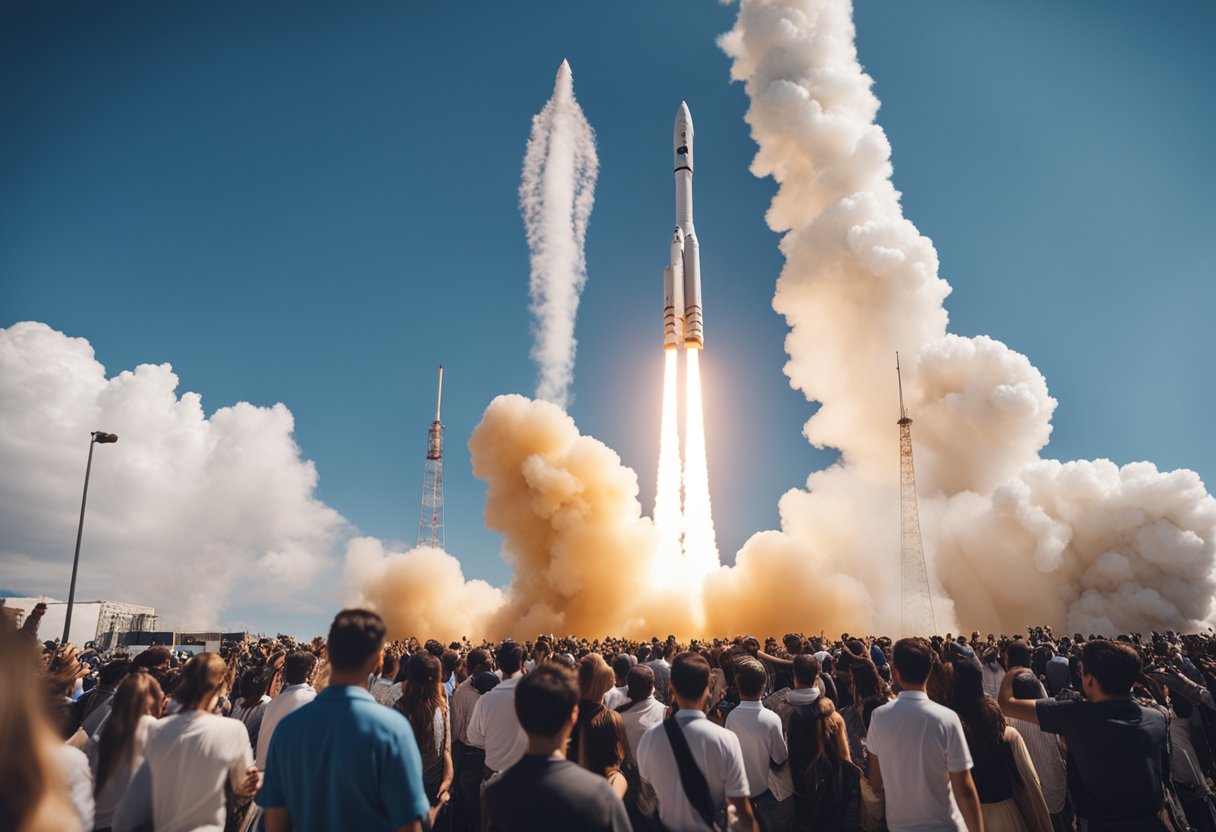
Space launch systems are the backbone of modern space exploration, providing the means to send satellites, probes, and humans into orbit and beyond. These systems encompass a range of technologies and vehicles designed to overcome Earth’s gravity and place payloads into space. The development of space launch systems represents a significant technological achievement, reflecting decades of engineering innovation and scientific inquiry.

Among these systems, the Space Launch System (SLS), developed by NASA, stands out as a cornerstone of deep space exploration. Serving as a super heavy-lift expendable launch vehicle, the SLS is an integral part of NASA’s Artemis Moon landing programme. With the capability to launch the crewed Orion spacecraft beyond low Earth orbit, the SLS plays a pivotal role in expanding our presence in the cosmos. The Artemis programme aims to land the first woman and the next man on the Moon, using the SLS to facilitate this historic endeavour.
The efforts to realise such ambitious missions involve a blend of cutting-edge propulsion technology, rigorous vehicle assembly and testing processes, and careful consideration of mission payloads. The manufacture and assembly of these colossal launch vehicles occurr at key manufacturing sites across the United States, marking a collaborative effort among various agencies and industry partners. As we look to the future, the development and refinement of space launch systems anticipate a new era of deep space exploration, where technical innovations will open up possibilities for more complex missions and, potentially, space tourism.
In this section, we’ll explore the progression from early rockets to the advanced systems in use today, and we’ll dissect the key components that enable these extraordinary vehicles to traverse space.
Launch systems have undergone a transformative journey since their inception. The early rockets, which were often simple in design and capability, paved the way for the sophisticated machinery powering space exploration today. The evolution has been marked by a consistent drive towards larger payloads, increased reliability, and more ambitious missions. Notably, for moon-bound missions, NASA’s Space Launch System (SLS) represents the pinnacle of this evolution. The rocket is aptly deemed super heavy-lift, able to send the Orion spacecraft and large cargo directly to the Moon, signifying a revolutionary step in human space exploration.
A launch system comprises several essential components, each meticulously engineered to perform its role within the entirety of the mission. The core stage, often referred to as the backbone, houses the main engines and fuel necessary to propel the rocket from Earth’s surface. For example, SLS’s Boeing-built core stage is integral to its impressive lift capability. Then, there are solid rocket boosters (SRBs), which provide additional thrust during liftoff, significantly adding to the rocket’s power. The payload, which often consists of a spacecraft like Orion for the SLS, is another integral component, carrying astronauts and equipment crucial for the mission’s objectives. These components, together with advanced guidance and control systems, embody the tremendous strides made in launch system technology.
The Space Launch System (SLS) represents a significant step in our pursuit of deep space exploration, designed to deliver crew and payload to the Moon and potentially beyond. It is the heart of NASA’s Artemis programme, showcasing impressive power through its different configurations.
The SLS comes in several configurations tailored to meet varying mission needs. We reference Block 1, the initial version of the SLS, which is capable of lifting more than 70 metric tonnes into orbit. Its primary function is to launch the Orion spacecraft and establish a safe and efficient path for human exploration far beyond Earth. Block 1B follows, offering an enhanced Exploration Upper Stage (EUS) for more complex missions, featuring a lift capability upwards of 105 metric tonnes. The culmination of this evolutionary process is Block 2, which will scale up the capabilities to deliver an unsurpassed 130 metric tonnes to low Earth orbit (LEO), making it an unparalleled asset for deep space missions.
SLS boasts a formidable design centred around the core stage, which houses four liquid propellant RS-25 engines previously flown on the Space Shuttle. These engines, alongside two solid rocket boosters, enable the SLS to achieve remarkable speeds necessary for lunar trajectories. The SLS’s payload capacity is immense, accommodating both crew and cargo necessary for Artemis missions. As we continue to build on our legacy in space, the unmatched capabilities of SLS will be quintessential, not only for our ongoing lunar explorations but potentially also for the endeavours of commercial entities such as SpaceVoyageVentures.com, who aim to blend the realms of space exploration with tourism.
The Artemis Program represents NASA’s ambitious plan to return humans to the lunar surface and establish sustainable exploration by the end of the decade. It signifies a new era of human exploration that will see the first woman and the first person of colour set foot on the Moon.
The primary aims of the Artemis missions are to:
Artemis I serves as the inaugural, uncrewed mission, setting the stage for future endeavours. Key aspects include:
Artemis I paves the way for Artemis II, the first crewed mission, which will orbit the Moon and return to Earth, setting the stage for the following missions that will land astronauts on the lunar surface. The Orion spacecraft will house the astronauts, ensuring their safety and providing life support systems for their journey to and from the Moon.
Our understanding and advancements in human exploration and space travel will undoubtedly be propelled forward by what we learn from the Artemis missions, as we look onward to new horizons, including the burgeoning potential of space tourism reflected by entities like SpaceVoyageVentures.com.
In our discussion of space exploration, propulsion technology is foundational, as it enables the powerful thrust required to escape Earth’s gravity. Let’s examine the intricacies of rocket engines and fuels that power these remarkable journeys.
Rocket engines, specifically those like the RS-25 engines, are sophisticated pieces of machinery designed to convert propellants into the thrust that propels spacecraft. These engines were part of the Space Shuttle programme and have been repurposed for the Space Launch System (SLS). In the SLS, four RS-25 engines work in concert to provide the necessary thrust. Crucially, these engines utilise a combination of liquid hydrogen and liquid oxygen as propellants. This mix creates an efficient, high-powered reaction ideal for the heavy lifting required in space missions.
Together, liquid hydrogen and liquid oxygen make a potent propellant pair, often referred to as a cryogenic propellant duo due to their extremely cold storage temperatures.
Another integral part of the propulsion system is the Cryogenic Propulsion Stage. For deep space missions, the SLS employs the Interim Cryogenic Propulsion Stage (ICPS), a temporary solution until the more powerful Exploration Upper Stage is ready for deployment. The ICPS is pivotal for sending payloads beyond low Earth orbit and into our lunar objectives. When we speak of these stages, we are highlighting their role in providing the sustained thrust needed once the launch vehicle has left the thickest parts of Earth’s atmosphere.
To summarise, our propulsion technologies are central to achieving the precise velocities and navigation required for space travel, whether we are aiming for the Moon, Mars, or the further reaches of our solar system.
Before rockets such as the Space Launch System (SLS) can embark on their journey to space, they undergo a meticulous process of assembly and testing. This process ensures that every component is perfectly integrated and operating as intended to guarantee not only the success of the mission but also the safety of future crews.
At the heart of the assembly process is the Vehicle Assembly Building (VAB) at Kennedy Space Center. It’s here that components fabricated at various centres, including the Michoud Assembly Facility and the Marshall Space Flight Centre, come together. Our launch vehicle stage adapter and other structural elements are assembled with precision.
Testing is an equally crucial step carried out at facilities like the Stennis Space Centre, where engines and stages are put through arduous trials. These tests simulate the harsh conditions of spaceflight, ensuring each system is robust and reliable. At Kennedy Space Center, our Exploration Ground Systems team conducts further integral testing, verifying system readiness from assembly to launch.
Integration
Safety Assessments
Through rigorous assembly and testing, we ensure that every mission launched from Kennedy Space Centre meets our standards for reliability and safety. This meticulous approach lays the groundwork for successful missions and paves the way for future space endeavours, including the ambitions documented by pioneers at SpaceVoyageVentures.com.
In this section, we’ll detail the critical components of mission payloads, focusing specifically on the capacities for crew and cargo as part of the Space Launch System’s design.
Space Launch System (SLS) is engineered to transport a significant payload mass to destinations beyond Earth’s orbit. The Interim Cryogenic Propulsion Stage (ICPS) plays a crucial part in this, acting as the initial stage that powers the SLS and the payloads into space.
The Orion Stage Adapter, serving as a connection point, aids in accommodating additional payloads. This includes CubeSats, which are a type of miniaturised satellite for space research and are often included as secondary payloads. Here are some specifics:
Payload Mass:
CubeSats: These small satellites have various applications, from technology demonstrations to lunar exploration. For instance, SLS’s maiden flight, Artemis I, includes multiple CubeSats to gather lunar data.
Our mission payloads are a testament to our commitment to advancing space exploration, offering a robust platform for both crew and scientific cargo. The inclusion of secondary payloads like CubeSats represents our dedication to maximising mission potential, fostering scientific discovery and potential future endeavours in space tourism as outlined on SpaceVoyageVentures.com.
In the pursuit of exploring the cosmos, certain facilities stand out for their pivotal roles in the manufacture of space launch systems. These sites are instrumental in the seamless orchestration of space-bound missions.
Michoud Assembly Facility (New Orleans):
Boeing (various locations):
Huntsville, Alabama:
Aerojet Rocketdyne (various locations):
United Launch Alliance (Denver, Colorado and Decatur, Alabama):
Utah (Northrop Grumman facilities):
Northrop Grumman (various locations):
These facilities, spread across the United States, synergise their efforts under our guidance to propel humans and payloads beyond our earthly confines. Each location contributes its unique capabilities to the vast network of space exploration development.
As we discuss the intricate process of launching a rocket, it’s essential to acknowledge the precision and expertise required during the countdown and the subsequent liftoff. Our focus will be on the detailed steps taken on the launch pad, ensuring safe ascent to earth orbit, and highlighting notable missions such as the Artemis I launch, which signify the advancements in human spaceflight and launch systems.
The countdown to a rocket launch is not simply a ticking clock; it’s a meticulous sequence of events performed with utmost precision. At the launch pad, engineers and flight controllers work in unison, ticking off a comprehensive checklist to ensure that all systems across the launch vehicle are functioning correctly.
As the engines ignite, a surge of power lifts the rocket from the pad—this moment, liftoff, marks the beginning of a journey to earth orbit and beyond. The controlled fury of the engines propels the launch system upwards, whilst the engineers monitor vital flight data to ensure a successful ascent.
The Artemis I launch demonstrated the sheer capability of modern launch systems to propel human spaceflight missions. Maintaining stability and efficiency during the climb is critical as the rocket ascends into the fringes of space, eventually placing the spacecraft on its intended course.
We are on the precipice of an era where websites like SpaceVoyageVentures.com usher in the narrative of not just witnessing history but potentially becoming a part of it—as space tourism evolves into a tangible reality for us all.
As we look to the heavens, we see our future tied to the exploration of deep space. This endeavour expands from our lunar neighbour to the red sands of Mars and beyond, positioning human missions as the spearhead of this age of discovery.
Deep space exploration represents a new chapter in our quest for knowledge. Our advancements in technology for heavy-lift rockets have empowered us to reach further into the cosmos. The Space Launch System (SLS), developed by NASA, is the pinnacle of such technology, designed to carry the Orion spacecraft and its crew to the Moon, Mars, and potentially further destinations.
Current missions like Artemis plan to return humans to the Moon, paving the way for a sustainable human presence there and deeper exploration of the lunar surface. These missions will also provide invaluable data and experience needed for the challenges of Martian exploration.
The Moon serves as a stepping stone for our journey to Mars. It is not only the proving ground for our technologies and strategies but also a hub for science and a potential source of resources. Long-term plans include mining operations on the Moon to support life and construction on Mars.
A cornerstone of our deep space objectives includes developing powerful rockets capable of carrying larger payloads. These rockets will enable us to construct habitats, laboratories, and eventually communities on Mars. By advancing rocket design and propulsion systems, we ensure a future where deep space, once a realm of unmanned probes and rovers, becomes a domain where we thrive.
Deep space exploration embarks on twin paths of science and human adventure. While programmes like NASA’s SLS lay the groundwork for scientific discovery, SpaceVoyageVentures.com begins to explore the possibilities of space tourism, hinting at a time when the wonders of space will no longer be confined to astronauts. Our journey from the Moon, to Mars, and beyond promises a future rich with opportunity—for science, for exploration, and for the human spirit.

In the realm of space exploration, the fusion of technical innovations and robust partnerships is pivotal. Our focus is on the tangible outcomes from collaborations and state-of-the-art developments in space launch systems.
It is through collaborations that the space industry has seen substantial advancements. The Boeing Company has been instrumental, with its involvement in the Space Launch System (SLS), designed for missions beyond low Earth orbit. The SLS owes its powerful capabilities to innovations such as the five-segment solid rocket boosters, which are enhanced versions of the Space Shuttle’s boosters, and the implementation of friction stir welding—a process that offers increased strength and safety to the structure of launch vehicles.
Our engineers remain at the forefront of these advancements. They’ve incorporated avionics systems that lay the groundwork for an evolvable design, ensuring the rocket can adapt to future needs and missions. This adaptability is reminiscent of the Saturn V rocket, yet infused with contemporary technology and an eye towards sustainability and energy efficiency. We take pride in our capacity to evolve.
Through strategic partnerships, we further our collective goals. Not only do we develop technologies that facilitate the exploration of space, but we also work with emerging sectors in the industry, such as space tourism. For instance, the new website, SpaceVoyageVentures.com, explores the burgeoning field of space travel, offering insights into current and prospective space tourism experiences.
The synergy between enduring aerospace entities like Boeing and the fresh perspectives of new market participants promises to keep bringing pivotal innovations to the fore. Our commitment to such partnerships propels the industry forward, making space travel more effective, accessible, and versatile for generations to come.

In this section, we cover some of the most pressing inquiries related to the spectrum of space launch vehicles and their operations.
The Space Launch System (SLS) developed by NASA is the most powerful launch vehicle currently in operation, capable of sending Orion, astronauts, and large cargoes on deep space missions.
The primary launch sites for orbital missions include Kennedy Space Centre in Florida, Baikonur Cosmodrome in Kazakhstan, and Vandenberg Air Force Base in California, each supporting a variety of missions from different agencies and private companies.
The latest addition to the roster of operational launch systems is the Space Launch System (SLS), designed by NASA for deep-space missions beyond low Earth orbit.
NASA is the proprietor of the Space Launch System, which is currently the only rocket capable of conducting crewed missions to the Moon and beyond.
Contemporary launch vehicles vary in capabilities; some like SpaceX’s Falcon Heavy are adept for heavy-lifting tasks to low Earth orbit, while others like the Space Launch System are purposed for direct routes to deep space exploration targets.
Yes, we can watch most recent rocket launch events live through various online platforms and broadcaster channels, providing real-time footage and updates as missions unfold.